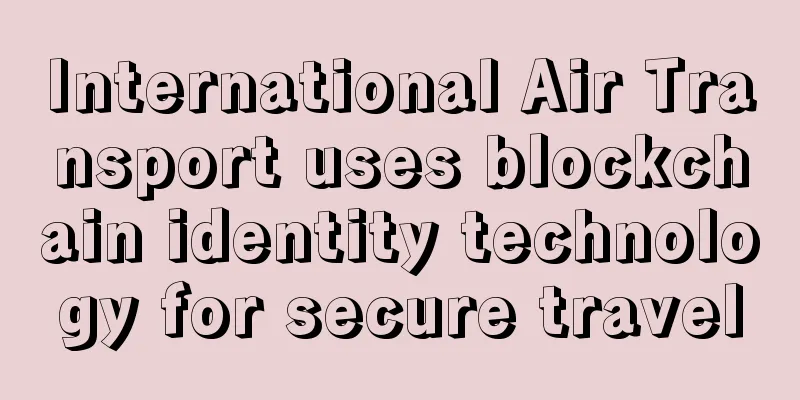International Air Transport uses blockchain identity technology for secure travel

|
SITA, the leading IT business solutions and communications service provider for the global air transport industry, is exploring the potential of blockchain technology to provide passengers with a secure single travel identity at airports and border controls. This revolutionary technology enables secure and effective biometric identification of passengers when they undergo border control. In addition to replacing multiple travel documents, passengers do not need to share personal data. SITA’s technology research group, SITA Lab, is currently investigating how virtual or digital passports could be used as a single, secure identifier on mobile and wearable devices, thereby reducing the complexity, cost and disadvantages of document checks during travel. Jim Peters, SITA Chief Technology Officer, said: “SITA’s vision is to create safe and seamless travel. So far, technology has helped SITA achieve this goal at many airports and more than 30 border control points around the world. However, the current computer system configuration requires multiple data exchanges between different agencies and multiple control links, which makes it difficult to create a single global system.” “Now, blockchain technology has given us the opportunity to provide a completely new way to use biometrics. Biometrics will be widely used at border checkpoints and all airports without the need for each relevant agency to store passenger information.” SITA’s innovative research envisions passengers creating a verifiable “identity” on their phone that contains their biometrics and other personal data. In future travel enabled by this technology, any relevant agency could easily scan your face and device to determine if you are an authorized passenger, no matter where in the world you are traveling. This can be achieved without the agencies having to control or store the passenger’s biometric information. SITA Lab has been working with blockchain technology pioneer ShoCard on the initial prototype of these concepts, which were demonstrated at the SITA Air Transport IT Summit in Barcelona. “At ShoCard, we’ve witnessed a digital revolution when travelers provided their verifiable identity information to a third party,” said Armin Ebrahimi, Founder and CEO of ShoCard. “Today, we are demonstrating how an identity platform built on blockchain technology, combined with SITA’s unique air transport and border management solutions, can improve the travel experience while ensuring security.” Peters added: “Blockchain technology offers a revolutionary approach to computing. It fundamentally changes the way we design systems because we can now create globally decentralized and distributed databases that are tamper-proof. However, it is still in its early stages and its scalability and adoption have yet to be tested. But SITA Lab is now focusing on how the air transport industry – airlines, airports and government agencies – can take advantage of the new era of trust that blockchain technology can provide, rather than relying on individuals or institutions.” SITA researchers are working on a universal security system to ensure that a single travel identity works globally and at all border checkpoints. Blockchain is designed to protect privacy from the beginning, so that passenger data can be secure, encrypted and tamper-proof and cannot be used for any other purpose. At the same time, no single organization needs to own, process or store the data. Blockchain, a cryptographic computer science, creates a network of trust where everyone can verify the source and history of the data. Peters added: “This is a completely new way of working, but at its core, a ‘blockchain’ is just a database where anonymous records and confirmations are processed. Whether it is used for currency circulation or travel, it is just a record of events shared between multiple parties, but most importantly, once the information is entered, it cannot be changed, and privacy and security are protected by design.” SITA's research into the future of traveller identification is part of its ongoing research investment for the benefit of the entire air transport industry. Identity management enables passengers to move safely and quickly through airports and is one of five industry research projects SITA has launched to address some of the industry's toughest challenges. The other four projects are: new baggage tracking capabilities to meet the requirements of IATA Resolution 753, the rollout of IATA's New Distribution Capability (NDC), an industry-wide disruption warning system and strengthening cybersecurity across the industry. |
<<: Bitcoin Banks as Monetary Utilities Want to Shut It Down
>>: Blockchain Technology (10): Ethereum Decentralized Taobao Smart Contract Case
Recommend
4 facial features of a woman to determine whether she can have children
It is not easy for a beautiful woman to give birt...
The facial features of men with miserable lives. It turns out that these men have no good luck.
By looking at a person's face, you can know h...
What does it mean if there is an island pattern among the three main lines of palmistry?
Island Pattern It is formed by the intersection o...
How does Phoenix Eye tell whether your career fortune is good or bad?
Eyes are the windows to one's soul, so they w...
Hong Kong retail investors can use securities accounts to invest in spot Bitcoin and Ethereum ETFs
The launch of Hong Kong Bitcoin and Ethereum spot...
The eyes can tell a person's good or bad fortune
The eyes can tell a person's good or bad fort...
What does it mean when the love line forks upwards?
What does it mean when the love line forks upward...
How to tell whether your marriage is happy or not from your face
Marriage is a major event in life and also anothe...
Coinbase to go public on April 14! Announces Q1 earnings ahead of schedule -
Cryptocurrency giant Coinbase announced on Thursd...
The most unlucky facial features
The most unlucky facial features Speaking of peac...
Halving will not have an immediate effect, miners may capitulate in the short term
After a brief spike to $10,600 on October 26, Bit...
A mole on the left ring finger can be auspicious or ominous
When getting married, the newlyweds will exchange...
What is the fate of people with short eyebrows?
In life, we often see that some people have good ...
What does a mole on a woman's face mean?
The appearance of moles is related to our fortune...
How does a woman with bulging eyes look like? What does a woman with a bad heart look like?
When interacting with others, the first thing peo...









